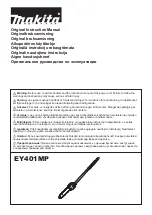
GB
- 23 -
Total vibration values (vector sum of three direc-
tions) determined in accordance with EN 61029.
Vibration emission value a
h
= 6.116 m/s
2
K uncertainty = 1.5 m/s
2
Warning!
The speci
fi
ed vibration value was established in
accordance with a standardized testing method. It
may change according to how the electric equip-
ment is used and may exceed the speci
fi
ed value
in exceptional circumstances.
The speci
fi
ed vibration value can be used to
compare the equipment with other electric power
tools.
The speci
fi
ed vibration value can be used for initi-
al assessment of a harmful e
ff
ect.
Keep the noise emissions and vibrations to a
minimum.
•
Only use appliances which are in perfect wor-
king order.
•
Service and clean the appliance regularly.
•
Adapt your working style to suit the appliance.
•
Do not overload the appliance.
•
Have the appliance serviced whenever ne-
cessary.
•
Switch the appliance off when it is not in use.
Residual risks
Even if you use this electric power tool in
accordance with instructions, certain resi-
dual risks cannot be rules out. The following
hazards may arise in connection with the
equipment’s construction and layout:
1. Lung damage if no suitable protective dust
mask is used.
2. Damage to hearing if no suitable ear protec-
tion is used.
3. Health damage caused by hand-arm vib-
rations if the equipment is used over a pro-
longed period or is not properly guided and
maintained.
5. Before starting the equipment
Before you connect the equipment to the mains
supply make sure that the data on the rating plate
are identical to the mains data.
Always pull the power plug before making
adjustments to the equipment.
5.1 General information
•
The equipment must be set up where it can
stand securely, i.e. it should be bolted to a
workbench, a universal base frame or similar.
•
All covers and safety devices have to be pro-
perly fitted before the equipment is switched
on.
•
It must be possible for the blade to run freely.
•
When working with wood that has been pro-
cessed before, watch out for foreign bodies
such as nails or screws, etc.
•
Before you actuate the On/Off switch, make
sure that the saw blade is correctly fitted
and that the equipment’s moving parts run
smoothly.
5.2 Setting up the saw (Fig. 1/3/16)
•
Insert the two workpiece support clips (13)
in the mounts (21) provided on the side of
the tool and fasten them in place with thumb
screws (22).
•
Insert the clamping device (19) into one of the
two mounts (20) provided on the top of stop
rail and fasten in place with the thumb screw
(33).
•
Screw the additional stability bar (32) to the
back of the machine.
5.3 Adjusting the saw (Fig. 1/2)
•
To adjust the rotary table (8), slacken the
locking handle (10) by approx. 2 turns and
press the latch (11) in order to unlock the ro-
tary table (8).
•
The rotary table (8) has latching positions at
0°, 15°, 22.5°, 30° and 45°. Once the latch
(11) is engaged you must also tighten the
locking handle (10) in order to fix the table in
position.
•
If you need to work with any other angles, the
rotary table is fixed in position with just the
locking handle (10).
•
Lightly press the machine head (4) down
while at the same time pulling the retaining
pin (16) out from the motor mounting; this
causes the saw to move down to the lower
working position. Turn the safety pin (16)
Anl_BT_MS_250_L_SPK1.indb 23
Anl_BT_MS_250_L_SPK1.indb 23
30.10.13 10:32
30.10.13 10:32
















































